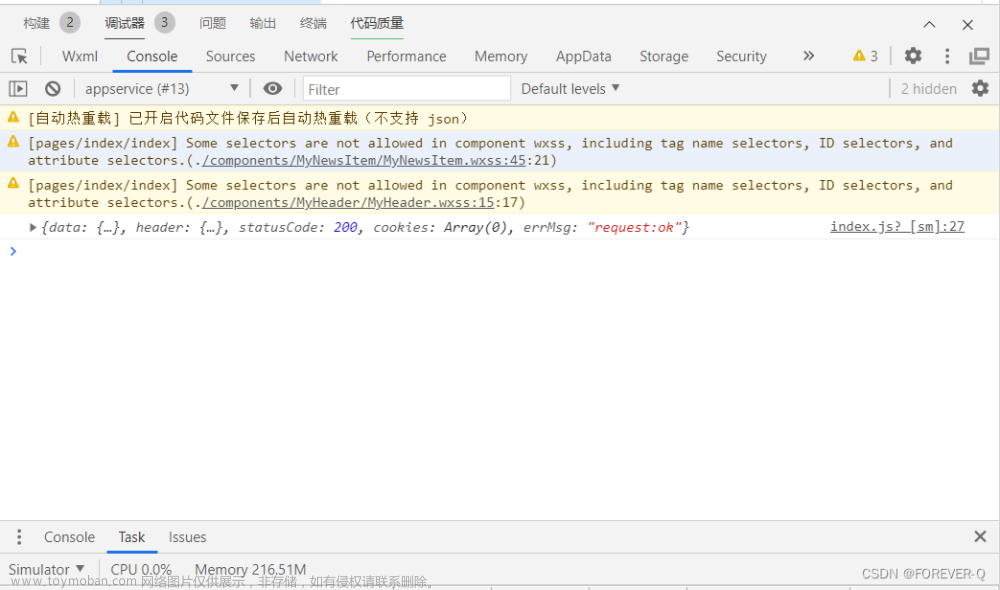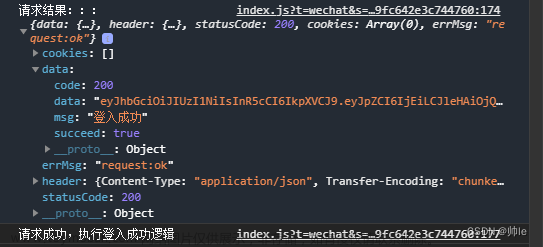网络请求基本演练和封装
网络请求基本演练
微信提供了专属的API接口,用于网络请求: wx.request(Object object)
| 属性 | 类型 | 默认值 | 必填 | 说明 |
|---|---|---|---|---|
| url | string | 是 | 开发者服务器接口地址 | |
| data | string/object/ArrayBuffer | 否 | 请求的参数 | |
| header | Object | 否 | 设置请求的 header,header 中不能设置 Referer。 content-type 默认为 application/json
|
|
| timeout | number | 否 | 超时时间,单位为毫秒。默认值为 60000 | |
| method | string | GET | 否 | HTTP 请求方法 |
| dataType | string | json | 否 | 返回的数据格式 |
| responseType | string | text | 否 | 响应的数据类型 |
上面众多属性中比较关键的几个属性如下:
url: 必传, 不然请求什么.
data: 请求参数
method: 请求的方式
success: 成功时的回调
fail: 失败时的回调
网络请求API基本演练
一般我们都是在页面的onLoad生命周期中发送网络请求
直接通过
wx.request(Object object)发送无参数GET请求:
Page({
data: {
allCities: {}
},
// onLoad生命周期发送网络请求
onLoad() {
wx.request({
// 发送网络请求的地址
url: "http://123.207.32.32:1888/api/city/all",
// 拿到请求的结果
success: (res) => {
// 将获取的结果保存到data中
const data = res.data.data
this.setData({
allCities: data
})
},
// 拿到错误信息
fail: (err) => {
console.log(err);
}
})
}
})
直接通过
wx.request(Object object)发送有参数GET请求:
Page({
onLoad() {
wx.request({
url: 'http://123.207.32.32:1888/api/home/houselist',
// 无论是POST请求还是GET请求, 参数都是在data中传递
data: {
page: 1
},
success: (res) => {
console.log(res);
},
fail: (err) =>{
console.log(err);
}
})
}
})
网络请求配置域名
每个微信小程序需要事先设置通讯域名,小程序只可以跟指定的域名进行网络通信。
小程序登录后台 – 开发管理 – 开发设置 – 服务器域名;
服务器域名请在 「小程序后台 - 开发 - 开发设置 - 服务器域名」 中进行配置,配置时需要注意:
域名只支持 https (wx.request、 wx.uploadFile、 wx.downloadFile) 和 wss (wx.connectSocket) 协议;
域名不能使用 IP 地址(小程序的局域网 IP 除外)或 localhost;
可以配置端口,如 https://myserver.com:8080,但是配置后只能向 https://myserver.com:8080 发起请求。如果向https://myserver.com、 https://myserver.com:9091 等 URL 请求则会失败。
如果不配置端口。如 https://myserver.com,那么请求的 URL 中也不能包含端口,甚至是默认的 443 端口也不可以。如果 向 https://myserver.com:443 请求则会失败。
域名必须经过 ICP 备案;
出于安全考虑, api.weixin.qq.com 不能被配置为服务器域名,相关 API 也不能在小程序内调用。 开发者应将 AppSecret 保存到后台服务器中,通过服务器使用 getAccessToken 接口获取 access_token,并调用相关 API;
不支持配置父域名,使用子域名。
网络请求的封装
小程序提供的网络请求用起来是很繁琐的, 并且容易产生回调地狱, 因此我们通常会对小程序的网络请求进行封装
封装网络请求有两个思路:
思路一: 封装成一个函数文章来源:https://www.toymoban.com/news/detail-408148.html
export function yqRequest(options) {
return new Promise((resolve, reject) => {
wx.request({
...options,
success: (res) => {
resolve()
},
fail: reject
})
})
}
- 这样我们发送网络请求就可以使用该函数, 使用该函数发送网络请求就可以通过Promise或者async和await获取结果
import { yqRequest } from "../../service/index"
Page({
onLoad() {
// 通过Promise获取结果
yqRequest({
url: "http://123.207.32.32:1888/api/city/all"
}).then(res => {
console.log(res);
})
yqRequest({
url: 'http://123.207.32.32:1888/api/home/houselist',
data: {
page: 1
}
}).then(res => {
console.log(res);
})
}
})
import { yqRequest } from "../../service/index"
Page({
onLoad() {
// 此处调用封装的异步函数
this.getCityData()
this.getHouseListData()
},
// 使用async和await获取结果, 为了防止同步最好再封装成独立方法
async getCityData() {
const cityData = await yqRequest({
url: "http://123.207.32.32:1888/api/city/all"
})
console.log(cityData);
},
async getHouseListData() {
const houseListData = await yqRequest({
url: 'http://123.207.32.32:1888/api/home/houselist',
data: {
page: 1
}
})
console.log(houseListData);
}
})
思路一: 封装成类(封装成类具备更强的扩展性)文章来源地址https://www.toymoban.com/news/detail-408148.html
// 网络请求封装成类
class YQRequest {
// 传入配置的baseurl
constructor(baseUrl) {
this.baseUrl = baseUrl
}
request(options) {
const { url } = options
return new Promise((resolve, reject) => {
wx.request({
...options,
url: this.baseUrl + url,
success: (res) => {
resolve(res)
},
fail: reject
})
})
}
get(options) {
return this.request({ ...options, method: "get" })
}
post(options) {
return this.request({ ...options, method: "post" })
}
}
export const yqRequest = new YQRequest("http://123.207.32.32:1888/api")
- 使用类的实例发送网络请求同样可以通过Promise或者async和await获取结果(这里不再演示async和await了)
import { yqRequest } from "../../service/index"
Page({
onLoad() {
// 使用类的实例发送网络请求
yqRequest.request({
url: "/city/all"
}).then(res => {
console.log(res);
})
yqRequest.get({
url: '/home/houselist',
data: {
page: 1
}
}).then(res => {
console.log(res);
})
}
})
到了这里,关于【小程序】网络请求API介绍及网络请求的封装的文章就介绍完了。如果您还想了解更多内容,请在右上角搜索TOY模板网以前的文章或继续浏览下面的相关文章,希望大家以后多多支持TOY模板网!








